Choosing a Gaming CPU October 2013: i7-4960X, i5-4670K, Nehalem and Intel Update
by Ian Cutress on October 3, 2013 10:05 AM ESTMetro2033
Our first analysis is with the perennial reviewers’ favorite, Metro2033. It occurs in a lot of reviews for a couple of reasons – it has a very easy to use benchmark GUI that anyone can use, and it is often very GPU limited, at least in single GPU mode. Metro2033 is a strenuous DX11 benchmark that can challenge most systems that try to run it at any high-end settings. Developed by 4A Games and released in March 2010, we use the inbuilt DirectX 11 Frontline benchmark to test the hardware at 1440p with full graphical settings. Results are given as the average frame rate from a second batch of 4 runs, as Metro has a tendency to inflate the scores for the first batch by up to 5%.
One 7970
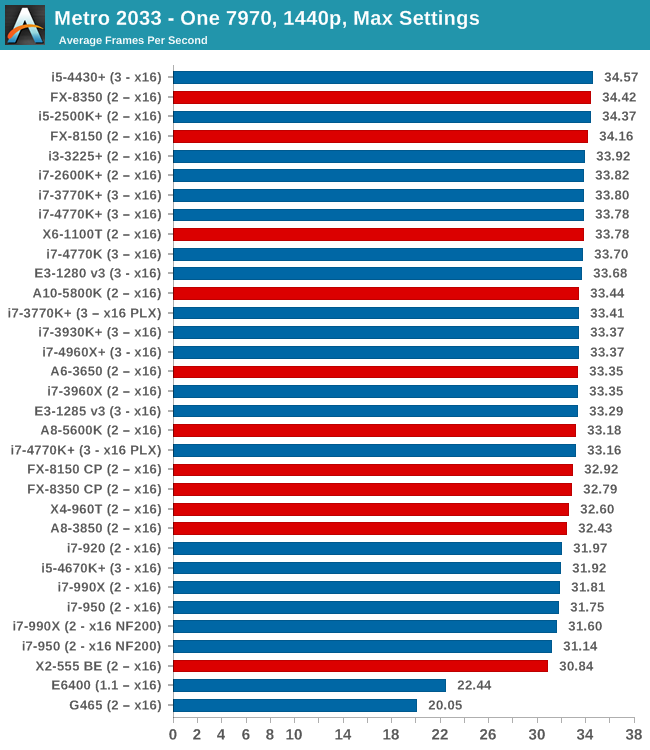
Almost all our test results fall between 31-35 FPS, which technically means a 10% difference between Nehalem CPUs and the latest Intel and AMD CPUs.
Two 7970s
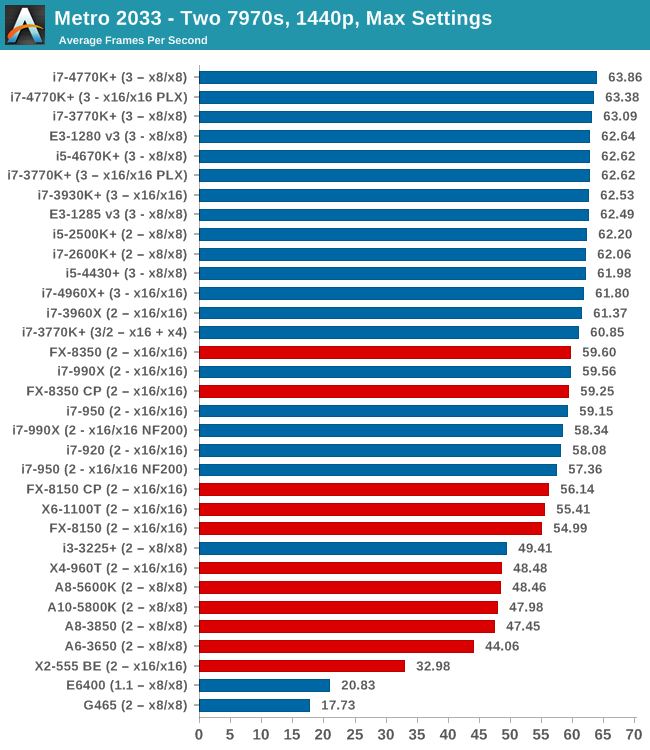
Doubling up to two 7970s and the Nehalems are in the ballpark of the Piledriver CPUs, but for comparison the quad core i5-4670K is similar to the full fat i7-4770K. Anything quad core and Intel, Sandy Bridge and above, hits 60 FPS average.
Three 7970s
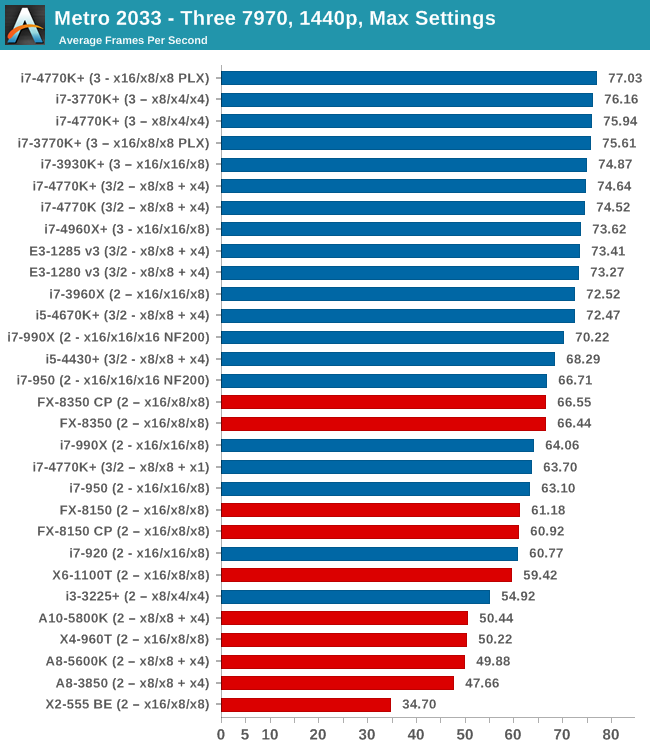
At three GPUs we have a bit more seperation going on, with the Nehalems losing out due to IPC - only on the NF200 enabled motherboard do we get 70 FPS. There are no benefits moving to the hex-core Ivy Bridge-E i7-4960X, but the jump from 4670K to 4770K nets five FPS.
One 580
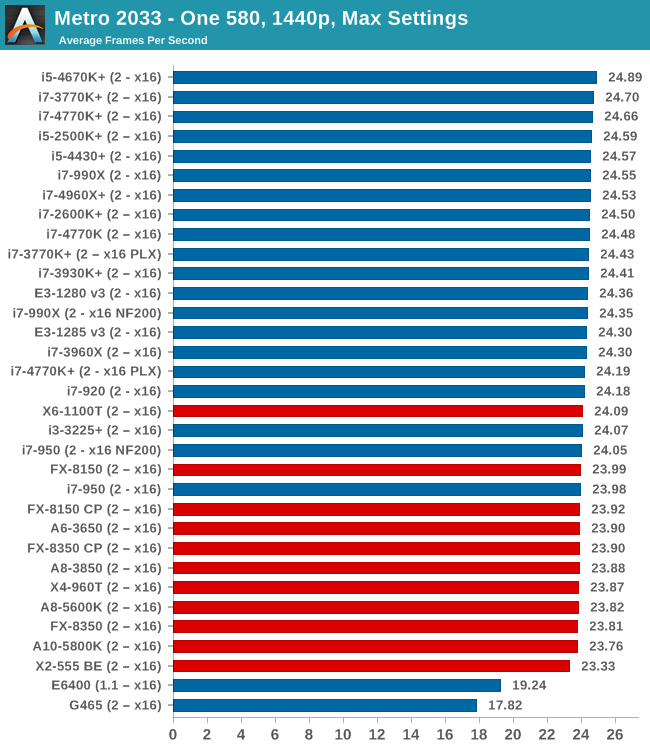
Similar to the 7970s, most modern CPUs perform the same. Beware of single core CPUs however, with the G465 not fairing well.
Two 580s
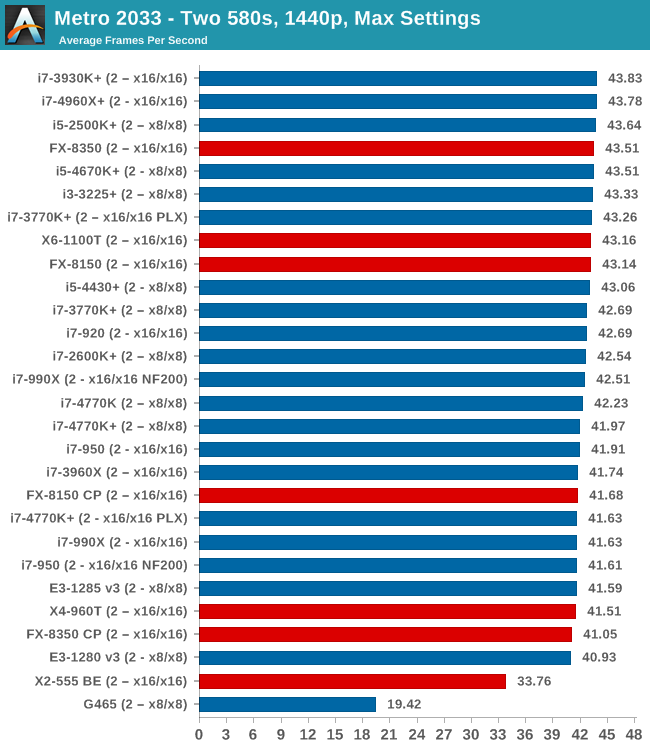
Similarly in dual NVIDIA GPU, there is not much difference - ~3 FPS at most unless you deal with dual core CPUs. Interestingly the results seem to be a little varied within that 41-44 FPS band.
Metro2033 Conclusion
In terms of single GPU, almost all the CPUs we have tested perform the same within a margin. On dual AMD GPUs we start to see a split, with the older Nehalem CPUs falling under 60 FPS. On tri-GPU setups the i5-4430 performs close to the Nehalems, and moving from 4670K to 4770K merits a jump from 72.47 FPS to 74-77, depending on lane allocation.










137 Comments
View All Comments
Democrab - Friday, October 4, 2013 - link
It's not really representative of most games, everyone knows it's highly CPU limited...Most games are GPU limited as proven by this, yet a lot of people seem unaware of that.Spoelie - Thursday, October 3, 2013 - link
Another choice I was considering for gaming: the i5 3350p.This is the cheapest i5 available on this side of the pond and still Ivy, so it allows the 4 bin overclocking. Since haswell, intel does not allow any overclocking anymore for non-K parts.
In addition, Z77 motherboards are quite a bit cheaper than Z87 for the moment.
So for a 30$+ cheaper than the 4430, you get 3.7/3.6/3.6/3.5ghz Ivy vs 3.2/3.0ghz Haswell.
The platform isn't that upgradeable but with Intel moving to 2-year cadences for desktop upgrades, the performance should stay relevant for at least 4 years...
mrdude - Thursday, October 3, 2013 - link
Amazing article, Ian. Thanks a ton.It's shocking to see how well the dual core Intel parts and the two-module AMD chips fare, even at 1440p with a single GPU. With respect to single-GPU gaming, opting to pull some $ out of the CPU/MB fund in order to buy a better GPU is certainly more advisable.
Those who invested in the X58/1366 platform certainly got their money's worth. Frankly, even buying a secondhand 1366 platform is a good idea if it's cheaper than a new quad-core 1155/1150 + mobo. Going from an SSD running on 3GB/s to 6GB/s really isn't noticeable. I've done this twice on two separate platforms and the only difference I've seen is with respect to bootup speed.
You also have to figure that this graph will change with the newer generation of console ports. I have an inclining that 2/4 threads might stumble a bit with some more demanding titles. We might even see AVX play a more significant role as well
cbrownx88 - Thursday, October 3, 2013 - link
BF4 is gonna bump me from X58 I believe... way more CPU bound than BF3 (1920x1200@4.2ghz)snouter - Wednesday, October 30, 2013 - link
BF4 makes my 4930k work more than I thought it would.BOMBOVA - Friday, October 4, 2013 - link
i am reviving my x58 MSI board, with Syba sata 3 controller, and i really notice a difference on my long video editing files. that was my whole point of modding up. Cheers. good discussionchizow - Thursday, October 3, 2013 - link
I really appreciated what this article tried to accomplish, and I think it does shed some light on some aspects of what you were trying to test...but someone at AnandTech couldn't throw you a bone and get you a pair of higher-end GPUs to test? 580s are a bit long in the tooth to garner any meaningful results. Maybe Gigabyte could have kicked a pair of 680s to you?Also, it would have been nice to see some Battlefield 3 results, since it is widely touted as a title that scales extremely well with both CPU (and shows big differences with HT) and GPU, especially in MultiPlayer, and will be especially relevant in the next few months as Battlefield 4 launches.
dusk007 - Thursday, October 3, 2013 - link
I find testing for CPU performance is not a strong suit of reviewers. The test has lots of data but it is missing the situations that gamers end up in which do require CPU performance.Starcraft 2. Just run a replay of an 8 player map at 4x-8x speed and most dual core notebooks practically break down.
Total War set unit size to epic and run some huge battle. That is where this games is great but it drains cpu resources like crazy.
Shooters or racing games are examples where the CPU has to do nothing but feed the GPU which is really the least CPU intensive stuff. Mulitplayer adds quite a bit of overhead but it is still not something if you play you need to worry much about your CPU.
When testing CPU performance kick all those shooters to the curve and focus on RTS games with huge unit sizes.
It is the minimum frames at these games that require CPU performance. The situations where it gets annoying that in the biggest battles the CPU cannot keep up. Starcraft 2 on medium runs on almost any GPU but it can bring slower CPU quickly to its limits.
IanCutress - Thursday, October 3, 2013 - link
COH2 is planned for our next benchmark update to cover the RTS side. I know Rome II is also a possibility, assuming we can get a good benchmark together. As I mentioned, if possible I'd like to batch file it up so I can work on other things rather than moderate a 5 minute benchmark (x4 for repetitions for a single number, x4-8 for GPU configs to complete a CPU analysis, x25+ CPUs for scope).If you have any other suggestions for the 2014 update, please let me know - email address is in the article (or click on my name at the top).
Ian
anubis44 - Saturday, October 5, 2013 - link
"COH2 is planned for our next benchmark update to cover the RTS side."Excellent. This is one of my most-played games. In addition, I wouldn't be surprised if subsequent patches for this game didn't noticeably improve it's multi-threaded performance, so having older results will be nice to have once these patches are released in order to track the improvements.